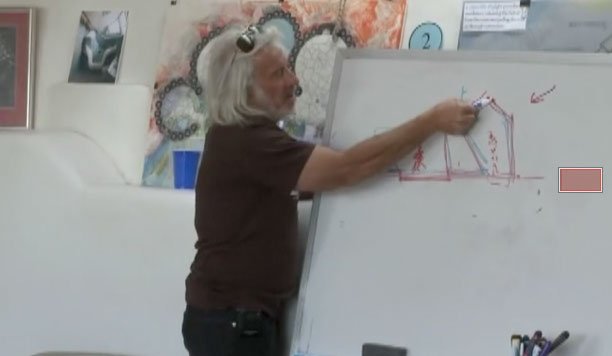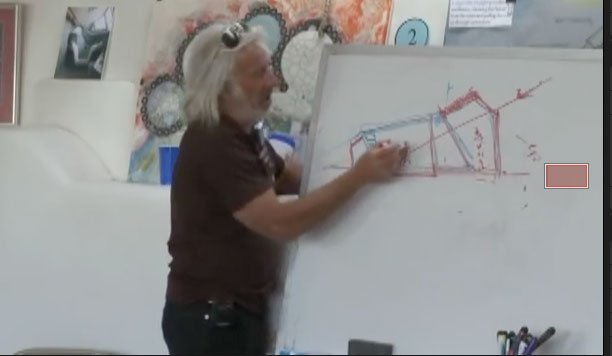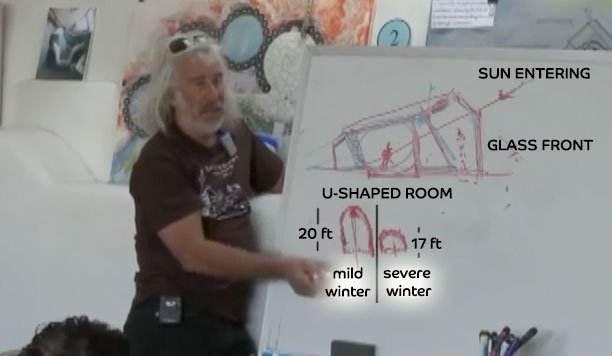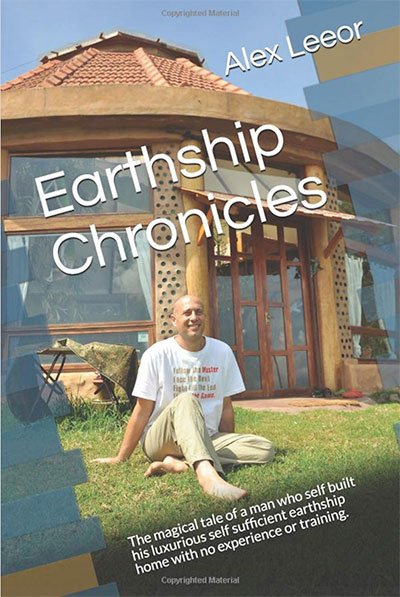Earthship Biotecture Transcribed Session 1 Pt 7: Q&A: Can you insure an earthship?, the double/triple greenhouse, the global model evolution + more
I would like to thank Mike Reynolds for giving me permission to transcribe, edit and reformat this work for the Steem Blockchain! This is part 7 of a Biotecture seminar. If you do read or watch this and have any questions please ask in the comments. I am happy to educate and help you to understand this. Biotecture is amazing in so many ways, and even after 20 years I still have not seen a model of sustainable building that even comes close in so many important areas such as performance, carbon footprint, longevity, ease of build, etc... Now you can also come to understand what Biotecture Really Is about!
Commentary
We continue a question and answer session with some important questions that help us understand why the global model earthship is now able to perform so well and stay warm at sub zero temperatures with little to no fuel. It is also able to provide a cool air convection current even at super hot desert heat, again with no fuel or moving parts. As Mike says, "Up in Montana, it felt like the air conditioner in your car hitting in your face." Learn how multiple greenhouses can buffer the inside temperature enough to stay warm at even -30 Celcius whilst at the same time providing suitable space for food production. This is a great chance to understand why earthships look the way they do, and what the limits and constraints are on things like room depth.
Did you know that the most recent Earthship built in south of the UK (Isle of Sheppey) was recently given an official NEGATIVE carbon footprint!!

Even during the cold UK winter Earthship Sheppey is staying warm with little to no fuel! More on that here: https://steempeak.com/ecotrain/@eco-alex/the-first-domestic-earthship-in-the-uk-receives-an-official-negative-carbon-footprint-mind-blown

Earthship Seminar Transcription Part 7
(Question:) In your opinion, I know that you build these over the world. Is there one climate that's easier to build an earthship and it makes it cheaper, easier that makes it perform better? -
Well...Obviously, I think sunny climates are easier 'cause you can get more power, more energy... sunny, cold climates, you know... But... we've done them so many different places that it's just... Our effort is to make them a universal design that can take care of people anywhere. And we used to have as you can see all these different... designs which are really gonna go away in our new education facility. Because we're gonna be presenting the current situation more. But, we've gone though so many different designs and they were all evolving due to all the different climates we were encountering. And we started seeing that well, if we can standardize a design that just gets tweaked for every climate, it becomes more available to people. Because that's the big things is that... Whatever you do it's gotta be easy for people to... to get it. To acquire it, to build it, to buy it, whatever. If you get too much custom and tailoring it just makes it too expensive, keeps you from standardizing, you know...the automobile industry, all the different industries have done a good job of that, in terms of standardizing their product. No matter how bad the product is. They've standardized it, so people can get it.
And so we learned from that because... part of getting something out there is making it, so that people can... can obtain it somehow. Somebody had a question over here.
(Question:) I was wonering about high tech glass technology for difference scenarios?
Well another thing that we're trying to do. And since we go around the world a lot, we get caught up on this. One thing that steers us away from glass is... We want to make these buildings, made of products that are available, in even a third world country. It turns out the tires, the cans, the cement and the rebar, some wood is available. Glass is... that's kept us from the high-tech glasses. But... If you got glass on a north side for whatever reason are... east or west even... then some of those kind of glasses, if you can afford them, makes some sense. You don't really need to use them on the front face because they retard solar gain. Some of them. And of course, the orgone field than... they're just radically more expensive. So we're trying to use materials that are... you know, I'd rather do a third green house and justify it with more water catchment, more food production, more sewage treatment. And see that's another thing, if you in a climate, a serious cold climate that your blackwater system, like we have here that green up the mesa is not gonna grow in for 6 months 'cause it's severe cold, that's another justification for another green house not only as a buffer zone and a water catchment and a sewage treatment, it lets the plants grow year around. May be they'll get down to 40 but plants are live and it's not freezing.
So... rather than go into higher-tech pieces of glass, we go into... just more green houses because it's really easy to justify them. People can have them. Like if you're in northern Canada and you build the global earthship. Then we set it up so you can add this, and we're doing that on quite a few right now. In phase two, they're gonna... they're gonna be surviving reasonable well with this, but they're gonna be super comfortable with this and have more plants and more sewage treatment and so on.
(Question:) When you added a third green house. Why do you pitch the roof up? Why don't you just maintain that straight line

I always draw that way because I relate it to the winter sun angle. So This angle would be less the further north you go... and closer to the equator you go it'll be higher except, then when it gets warm you don't even need it anyway. So in a northern climate I match this line with the winter angle of the sun. So the structure... this is glass. this is insulated structure. So that the sun makes it all the way house still. So I don't wanna block any sun by this buffer zone, I just wanna trap... more temperature so that this -40° is not felt all the way here, where the people are. So we're still trying to get the sun in.

(Comment:) It wouldn't be cheaper just go straight from that highest point to the lowest point on the back and have that...
Well, if you're gonna do it from the to get-go, yeah! That could be structured. But a lot of times, that's one way you could do it. But since this... in our efforts is to standardize since this... This is worthy of standardisation, this global model. Then this is an add-on to the global model. So, rather than change the whole structure of the global model we can keep it standardised and add this, and... when you do add this, you find that you have to adjust it. So you'd be dealing with separate set of drawings for every latitude, and we're trying to avoid stuff like that.
(Question:) Can you talk a little bit about what affects room depth ? If u have a U shape Kristen was saying you can go a bit further / deeper from the greenhouse?
Yeah, well room depth was... was in the early days a discussion. Because if you have a... If you have a mild winter. Then you can make their use pretty deep. 'Cause you're not getting that cold. And in fact, it's cooler back here in the summer time. And if you're having a severe winter, you make the rooms more shallow. Because then the sun, and the air space you're trying to heat is less relative to the similar glass space. In other words, this is considered your source of heat. So you got the same source of heat for a... much larger space than this much smaller space. So this is what you'd do in a severe winter, this is what you'd do in a mild winter.

So, that was the... that was the we played with the use. But then when we started going to... just making the whole building surrounded by the 7 ft (~213 cm) thick thermal mass, thermal wraped wall, we came up with two depths. we have one of 20... that's just to the vertical face. Then the... green houses added to that. So we have two depths we use now that are kind of universal to the world, really. 20 and 17. 17 is more sensitive to... performing better, 20 performs not quite as good in severe winter but it's okay. And so... the buffer zone helps make up for that. Then that gets in two structure. If you go much... see, our beams are spend this way, not like they used to on the U's. So when your beams spend this way, if you get more than 20 you'll start to getting into super trusses and heavy, heavy loads and... 17 is the best because it's an easy span. With either trusses or logs which is what we use, you'll see both in the community. And so, we're getting down to... a lot of the... like when we first came up with the package design, It was this way, it was a lot cheaper, it was a lot easier.
It was aimed though at being easier to put together. And we thought that we're gonna sacrifice some performance by making this thing easier to put together. Turn out that those package buildings really performed well. Then when we added... so, just to show you, see the orange is the package building, we did a lot of them, all over the world. And then... We started going well, we can even make them better by doubling the green house. And then... then we double the green house and got into this melting of water thing, and shoved that into a double green house with the sloped roof and it turned out to be... we call it the global because it works all over the globe. And so... this tuning of the U's, it's kind of old-school at this point. It's back into custom situation. There's nothing wrong with U's except that... there are more details to build them. Therefore more time consuming, therefore more expensive than these. The whole building is wrapped in the twice as thick wall. And so... what I'm getting at here is that the structure, thermal dynamics and price. All go into equally... determining the design of this building.
(Question:) So I have other questions. When you modified the design of the sloping design, are you trading off the skylights, or are skylights just not part of the global model anymore?
Well, they're gone. I mean they're nice. They're cool 'cause you can lay there in bed and look up at the stars And you can... just there's nothing... the light but see the buildings are more shallow than this. So you go in corner cottage, or... there's a couple of globals that are built, You're gonna find that... they're just as light as this room. You don't really that light. They're just as light because they're shallower. And they're actually cooler because now the air comes through the earth, See, if it's a 105°(F~40 °C) outside the air coming through that window and off the skylight is not really anything but fresh air. Whereas... if it's a 105° outside and we open up a convection driven air-current, that sucks this air through... 8 ft deep 30 feet long of buried dirt, you have an air conditioner. It feels, up in Montana, it felt like the air conditioner in your car hitting in your face. And so, we have better movement of air, cooler air and less or no openings in the roof. Like you go up on the roof on some of these buildings, you're seeing some of these newer buildings, you're seeing no detail. Details are money, detail is time. Where after the thing...
Up in Montana, it felt like the air conditioner in your car hitting in your face.
So what I'm saying is... Time and money do affect design because... you... that's gonna make it available to more people if it's not full of detail, like my original... and I still look at things this way... First of all, I want it to work. Like we're working on this heat bulb thing now. I don't care what is cost, what it looks like, how much space it takes up, I want it work. I wanna be able to put one in a corner of a room in Norway and have it emanate heat. And I'll stop at nothing to get that. But then after I get it working, then I'm going to try make it affordable to people to buy. And easy for people to acquire, and, and... on and on.
Why did Earthships used to look so weird?
So the first designs that we had with the overall building were, we don't care what the building looks like, a lot of the ones Kirsten showed you look like they landed last night, they weren't marketable, but they illustrated to us that... you can do this. So I keep that thinking as I go through to get into more your question too, whatever it takes to make it work without fuel, I will do it. Then, I will try to take into... the economics and the simplicity of making it more available to people. But... There's no sense in making it economical and available to people and easy to put together if it didn't work. I've gotta go through the making of work process first. And that process is at all cost. In other words, there's nothing that should stop you from trying to make a building that doesn't use fuel. Whatever it takes to do that, you have to do it. And that's kind of how these things are evolved. The buildings early on worked just like this one. But now, they're more available to people, less maintenance, more user friendly, on and on and on.
Can I Insure An Earthship?
(Question:) has anybody tried to get any of these structures insured? - Yeah! They actually have. - Yeah, there... Both the banking, landing and insuring are slowly getting easier and easier, because actually there's a trend, It got slammed to the recent economic crunch, but... there's a trend toward banks and insurance companies actually starting to favour carbon-zero buildings. They see, if this building is not gonna be a white elephant needing a ton of fuel in the future, then it is a better risk to loan on and to insure. So there's a trend for that, used to be the banks wouldn't touch them. You know, they're too weird. But now... that's another thing.
There's a trend toward banks and insurance companies actually starting to favour carbon-zero buildings. They see, if this building is not gonna be a white elephant needing a ton of fuel in the future, then it is a better risk to loan on and to insure.
We're... I don't necessarily agree with the economical world and the bank world and insurance world, I hate insurance, but... but the... The thing is we have to go there to relate to the masses of people that need these, and so, it's kind of a... you know, we will... not upstand on ceremony about certain things, just to... in other words to make this palatable to the large amounts of people. We can't be... what do you call it? Fanatics, although, I guess I am a fanatic. *laughter* Yeah!
Earthship Seminar Video 2009 - Part 7

READ PREVIOUS TRANSCRIPTS
Part 1
https://steemit.com/ecotrain/@eco-alex/earthship-biotecture-101-learn-with-michael-reynolds-part-1
Part 3
https://steempeak.com/ecotrain/@eco-alex/earthship-biotecture-transcribed-seminar-with-michael-reynolds-part-3
Part 4
https://steempeak.com/ecotrain/@eco-alex/earthship-biotecture-transcribed-pt4-heating-your-home-with-body-heat-in-norway-about-permits-in-usa-and-europe-how-to-get-them
Part 6

Did you know, I built four Earthships in India as well as being instrumental the creation of the first Earthship in the UK, Earthship Brighton. If you are also on this path and would like to read my story, I have recently published a book. It is not only a great story, but a valuable resource for you to learn from. I had no experience or training when I embarked on my mission, but managed to successfully build a gorgeous home called Earthship Karuna.
You can buy this book with Steem on the homesteaders co-op. Whilst you are there please do have a look at some of the other products as there are all kinds of great things there!


https://homesteaderscoop.com/product/earthship-chronicles-ebook/
If you don't have any Steem you can also buy the ebook and paperback on amazon.
http://mybook.to/Earthship-Chronicles
or
https://www.amazon.com/Earthship-Chronicles-sufficient-luxurious-experience-ebook/dp/B07MYCBXYB
@ecoTrain
Supporting People Who Help
Make The World A Better Place

Discover previous ecoTrain magazines at @ecoTrain
** Click Here To View Our Passenger Feed**


Your constancy in sharing this incredible, important knowledge impresses the fuck outta me! :) Resteemed.
Leading the curation trail for both @ecotrain & @eco-alex.
Together We’re Making This World A Better Place.
Click Here To Join the manually curated trail "@artemislives" to support quality eco-green content.
@ecoTrain
THANK you! yes i try to keep this one rolling.. there are MANY hours to transcribe!! =)
Hi @eco-alex. I´d love to have your book. but nowadays i do not have money. do you have a courtesy one please? I´d love to read it.
well, the good news is that the entire book is available for free on Steem! It is an unedited, imperfect version, but the story and details are the same.. there are also other workshops i have done tied up in this post.. you should be all set for plenty of reading! enjoy! <3
https://steempeak.com/earthship/@eco-alex/a-compilation-of-all-my-eco-building-and-workshop-posts-on-steemit
Thank you @eco-alex
You got a 63.66% upvote from @ocdb courtesy of @eco-alex! :)
@ocdb is a non-profit bidbot for whitelisted Steemians, current max bid is 35 SBD and the equivalent amount in STEEM.
Check our website https://thegoodwhales.io/ for the whitelist, queue and delegation info. Join our Discord channel for more information.
If you like what @ocd does, consider voting for ocd-witness through SteemConnect or on the Steemit Witnesses page. :)
@ocdb please, I think the steemit Witnesses page is fallacious. I tried to vote for @ocdb witness just only me added.
Thank you.
Posted using Partiko Android